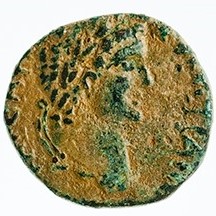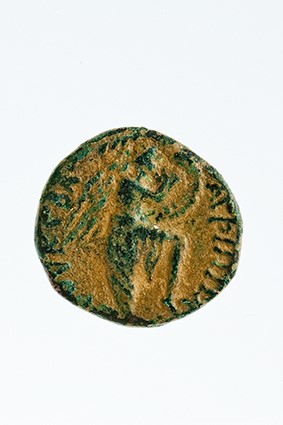Acquisition number: 1981.07
Obv.: Head of Domitian, r., laureate. (In Greek) ΔΟΜΙΤΙΑΝΟ[Σ] ΚΑΙΣΑΡ (Domitianus Caesar)
Rev.: Nike (Victory) standing, right, left foot on helmet, writing on shield supported on l. knee. (In Greek) date (‘the 27th year’) and ΑΓΡΙΠΠΑ (Agrippa). The legend on this coin is very worn, so the date is not certain.
Title: Bronze coin (Æ) of King Agrippa II - 1981.07
Acquisition number: 1981.07
Author or editor: Beryl Rawson
Culture or period: Roman Imperial
Date: AD c.83
Material: Metal - Bronze
Object type: Coins - Roman
Dimensions: 16mm (w)
Origin region or location: Türkiye
Origin city: Eastern mint: Ephesus?
Display case or on loan: 7
Keywords: Coin, Roman, Imperial, King Agrippa II, Domitian, Victory, Ephesos, Ephesus
Sear, D.R., Roman Coins and their Values 5 vols (London, Spink, 2000-2014) GIC 5580; Meshorer, Y., Ancient Jewish Coinage 2 vols (Amsterdam: Amphora Books, 1982) cf. numbers 128, 135.
Hill, G.K., Catalogue of the Greek Coins of Palestine (Bologna, Arnaldo Forni, 1965) cf. Agrippa II 244 no. 40.
1981.07
Bronze coin (Æ) of King Agrippa II
3.63 g. c.AD 83 (Eastern mint: Ephesus?)
Obv.: Head of Domitian, r., laureate. (In Greek) ΔΟΜΙΤΙΑΝΟ[Σ] ΚΑΙΣΑΡ (Domitianus Caesar)
Rev.: Nike (Victory) standing, right, left foot on helmet, writing on shield supported on l. knee. (In Greek) date (‘the 27th year’) and ΑΓΡΙΠΠΑ (Agrippa). The legend on this coin is very worn, so the date is not certain.
Agrippa (M. Iulius Agrippa), of the royal family of the Herods, was educated at Rome under Claudius and appears to have been thoroughly Romanised. From about AD 48, the Romans gave Agrippa increasing amounts of territory in the regions of Judaea. Agrippa supported the Romans in Judaea, even after the outbreak of the Jewish War in AD 66. He and his sister Berenice were expelled in AD 66, but he returned with Titus when the Romans won victory in this war, and he received extra territory. His coins are not official Roman coinage but carry imperial portraits. Here, the head is of Domitian, Vespasian’s younger son and Titus’ brother. Domitian bore the title ‘Caesar’ early, a sign of Vespasian’s intention to have a dynasty recognised.
The dates of Agrippa’s coins have been much debated, but Meshorer (1967: 81) accepted the argument of H. Seyrig that most of Agrippa’s coins take the year AD 56 as the first year of his reign, so coins ‘from the 14th year’ date from the year AD 70, the first year of Vespasian’s reign but also, perhaps more importantly for these coins, the year of the Roman victory over Judaea. This starting date is used for most of the coins issued with the name of Vespasian or Titus or Domitian and continued until the year of Agrippa’s death in AD 95.
Nike is usually associated with the Roman victory in Judaea.
Sear, D.R., Roman Coins and their Values 5 vols (London, Spink, 2000-2014) GIC 5580; Meshorer, Y., Ancient Jewish Coinage 2 vols (Amsterdam: Amphora Books, 1982) cf. numbers 128, 135.
Hill, G.K., Catalogue of the Greek Coins of Palestine (Bologna, Arnaldo Forni, 1965) cf. Agrippa II 244 no. 40.

